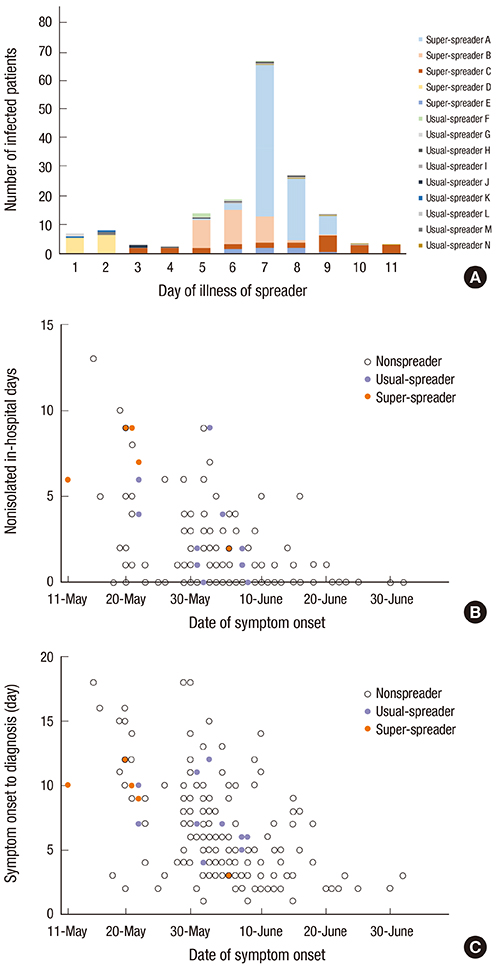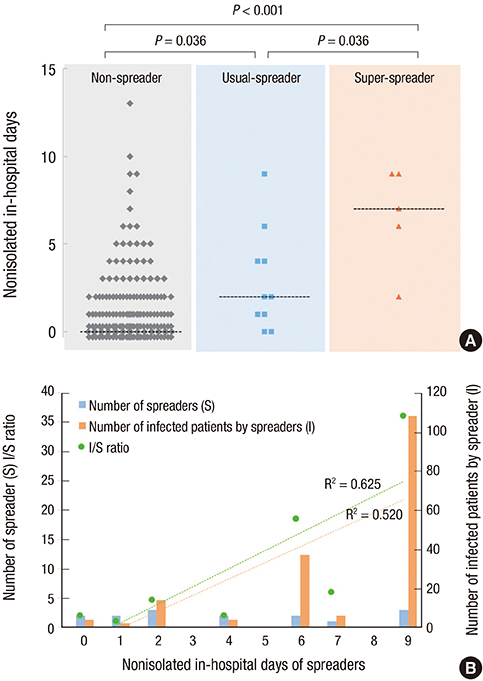Clinical and Epidemiologic Characteristics of Spreaders of Middle East Respiratory Syndrome Coronavirus during the 2015 Outbreak in Korea
- Affiliations
-
- 1Department of Internal Medicine, Seoul National University College of Medicine, Seoul, Korea. mdohmd@snu.ac.kr
- 2JW Lee Center for Global Medicine, Seoul National University College of Medicine, Seoul, Korea.
- 3Graduate School of Public Health and Institute of Health and Environment, Seoul National University, Seoul, Korea.
- KMID: 2375073
- DOI: http://doi.org/10.3346/jkms.2017.32.5.744
Abstract
- Nosocomial transmission is an important characteristic of Middle East Respiratory Syndrome Coronavirus (MERS-CoV) infection. Risk factors for transmission of MERS-CoV in healthcare settings are not well defined. During the Korean outbreak in 2015, 186 patients had laboratory-confirmed MERS-CoV infection. Those suspected as a source of viral transmission were categorized into the spreader groups (super-spreader [n = 5] and usual-spreader [n = 10]) and compared to the non-spreader group (n = 171). Body temperature of ≥ 38.5°C (adjusted odds ratio [aOR], 5.54; 95% confidence interval [CI], 1.38-22.30; P = 0.016), pulmonary infiltration of ≥ 3 lung zones (aOR, 7.33; 95% CI, 1.93-27.79; P = 0.003), and a more nonisolated in-hospital days (aOR, 1.32 per 1 day; 95% CI, 1.09-1.60; P = 0.004) were significant risk factors in the spreader group. There was no different clinical factor between super-spreaders and usual-spreaders. Nonisolated in-hospital days was the only factor which tended to be higher in super-spreaders than usual-spreaders (Mean, 6.6 vs. 2.9 days; P = 0.061). Early active quarantine might help reducing the size of an outbreak.
Keyword
MeSH Terms
Figure
Cited by 6 articles
-
Revised Triage and Surveillance Protocols for Temporary Emergency Department Closures in Tertiary Hospitals as a Response to COVID-19 Crisis in Daegu Metropolitan City
Han Sol Chung, Dong Eun Lee, Jong Kun Kim, In Hwan Yeo, Changho Kim, Jungbae Park, Kang Suk Seo, Sin-Yul Park, Jung Ho Kim, Gyunmoo Kim, Suk Hee Lee, Jeon Jae Cheon, Yang Hun Kim
J Korean Med Sci. 2020;35(19):e189. doi: 10.3346/jkms.2020.35.e189.An Atypical Case of Middle East Respiratory Syndrome in a Returning Traveler to Korea from Kuwait, 2018
Song Lee Bak, Kang Il Jun, Jongtak Jung, Jeong-Han Kim, Chang Kyung Kang, Wan Beom Park, Nam-Joong Kim, Myoung-don Oh
J Korean Med Sci. 2018;33(53):. doi: 10.3346/jkms.2018.33.e348.The Fight against the 2019-nCoV Outbreak: an Arduous March Has Just Begun
Jin-Hong Yoo
J Korean Med Sci. 2020;35(4):. doi: 10.3346/jkms.2020.35.e56.Facilities and construction in hospitals for infection control
Joong Sik Eom
J Korean Med Assoc. 2018;61(1):36-42. doi: 10.5124/jkma.2018.61.1.36.The First Case of 2019 Novel Coronavirus Pneumonia Imported into Korea from Wuhan, China: Implication for Infection Prevention and Control Measures
Jin Yong Kim, Pyoeng Gyun Choe, Yoonju Oh, Kyung Joong Oh, Jinsil Kim, So Jeong Park, Ji Hye Park, Hye Kyoung Na, Myoung-don Oh
J Korean Med Sci. 2020;35(5):. doi: 10.3346/jkms.2020.35.e61.Impact of the 2015 Middle East Respiratory Syndrome Outbreak on Emergency Care Utilization and Mortality in South Korea
Sun Young Lee, Young-Ho Khang, Hwa-Kyung Lim
Yonsei Med J. 2019;60(8):796-803. doi: 10.3349/ymj.2019.60.8.796.
Reference
-
1. Zaki AM, van Boheemen S, Bestebroer TM, Osterhaus AD, Fouchier RA. Isolation of a novel coronavirus from a man with pneumonia in Saudi Arabia. N Engl J Med. 2012; 367:1814–1820.2. World Health Organization. Middle East Respiratory Syndrome Coronavirus (MERS-CoV) [Internet]. accessed on 3 November 2016. Available at http://www.who.int/emergencies/mers-cov/en/.3. Korea Centers for Disease Control and Prevention. Middle East Respiratory Syndrome Coronavirus outbreak in the Republic of Korea, 2015. Osong Public Health Res Perspect. 2015; 6:269–278.4. Oh MD. The Korean Middle East Respiratory Syndrome Coronavirus outbreak and our responsibility to the global scientific community. Infect Chemother. 2016; 48:145–146.5. Chowell G, Abdirizak F, Lee S, Lee J, Jung E, Nishiura H, Viboud C. Transmission characteristics of MERS and SARS in the healthcare setting: a comparative study. BMC Med. 2015; 13:210.6. Oboho IK, Tomczyk SM, Al-Asmari AM, Banjar AA, Al-Mugti H, Aloraini MS, Alkhaldi KZ, Almohammadi EL, Alraddadi BM, Gerber SI, et al. 2014 MERS-CoV outbreak in Jeddah--a link to health care facilities. N Engl J Med. 2015; 372:846–854.7. Cho SY, Kang JM, Ha YE, Park GE, Lee JY, Ko JH, Lee JY, Kim JM, Kang CI, Jo IJ, et al. MERS-CoV outbreak following a single patient exposure in an emergency room in South Korea: an epidemiological outbreak study. Lancet. 2016; 388:994–1001.8. Stein RA. Super-spreaders in infectious diseases. Int J Infect Dis. 2011; 15:e510–e513.9. World Health Organization. Laboratory testing for Middle East Respiratory Syndrome Coronavirus: interim guidance [Internet]. accessed on 3 November 2016. Available at http://www.who.int/csr/disease/coronavirus_infections/mers-laboratory-testing/en/.10. Choi WS, Kang CI, Kim Y, Choi JP, Joh JS, Shin HS, Kim G, Peck KR, Chung DR, Kim HO, et al. Clinical presentation and outcomes of Middle East Respiratory Syndrome in the Republic of Korea. Infect Chemother. 2016; 48:118–126.11. Ministry of Welfare and Health (KR). MERS statistics [Internet]. accessed on 3 November 2016. Available at http://www.mers.go.kr/mers/html/jsp/main.jsp.12. Korean Society of Infectious Diseases; Korean Society for Healthcare-associated Infection Control and Prevention. The same Middle East Respiratory Syndrome-Coronavirus (MERS-CoV) yet different outbreak patterns and public health impacts on the far east expert opinion from the rapid response team of the Republic of Korea. Infect Chemother. 2015; 47:247–251.13. Min CK, Cheon S, Ha NY, Sohn KM, Kim Y, Aigerim A, Shin HM, Choi JY, Inn KS, Kim JH, et al. Comparative and kinetic analysis of viral shedding and immunological responses in MERS patients representing a broad spectrum of disease severity. Sci Rep. 2016; 6:25359.14. Ministry of Health and Welfare (KR). The 2015 MERS outbreak in the Republic of Korea: learning from MERS [Internet]. accessed on 3 November 2016. Available at http://www.mers.go.kr/mers/html/jsp/Menu_I/mers00_01.jsp.
- Full Text Links
- Actions
-
Cited
- CITED
-
- Close
- Share
- Similar articles
-
- An Unexpected Outbreak of Middle East Respiratory Syndrome Coronavirus Infection in the Republic of Korea, 2015
- The Same Middle East Respiratory Syndrome-Coronavirus (MERS-CoV) yet Different Outbreak Patterns and Public Health Impacts on the Far East Expert Opinion from the Rapid Response Team of the Republic of Korea
- Costly Lessons From the 2015 Middle East Respiratory Syndrome Coronavirus Outbreak in Korea
- The Korean Middle East Respiratory Syndrome Coronavirus Outbreak and Our Responsibility to the Global Scientific Community
- Middle East respiratory syndrome: what we learned from the 2015 outbreak in the Republic of Korea



